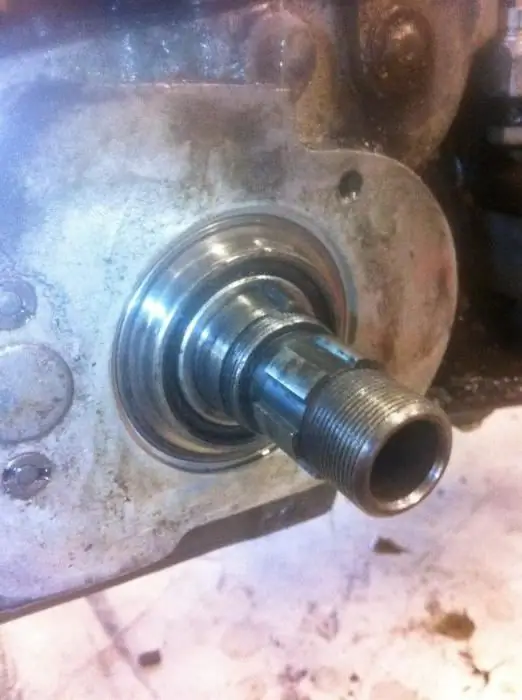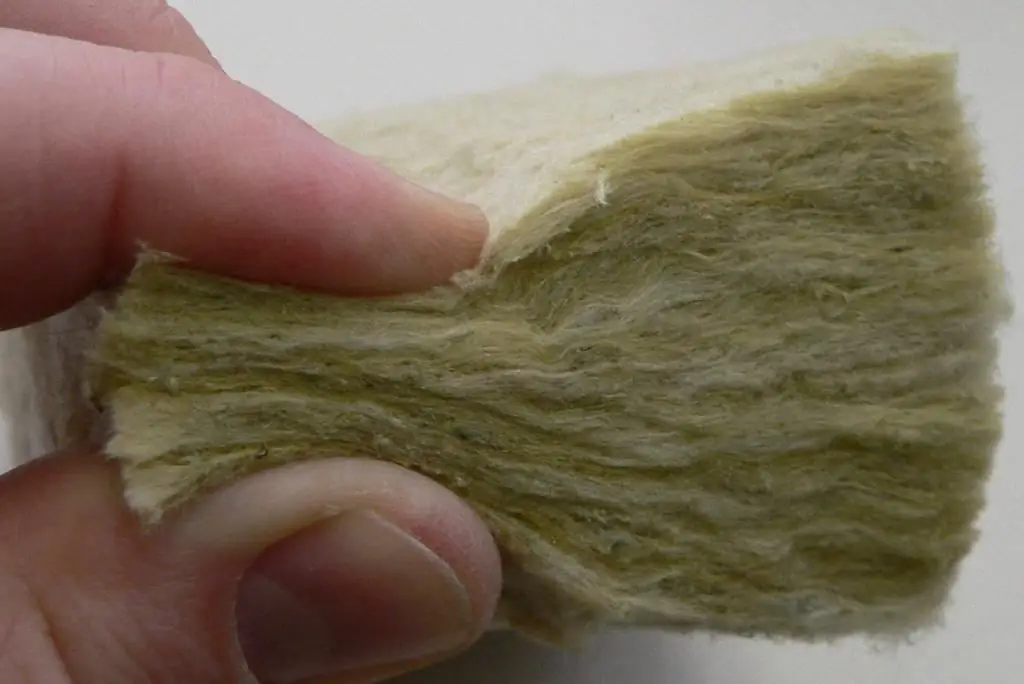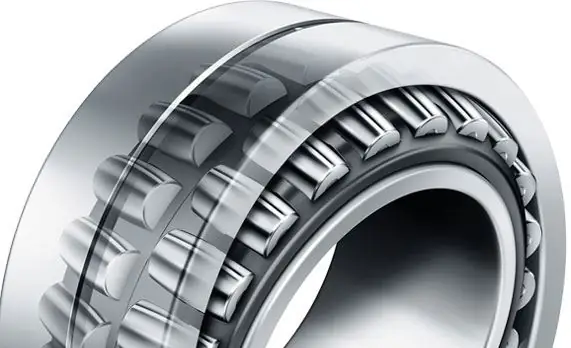2025 Author: Howard Calhoun | [email protected]. Last modified: 2025-06-01 07:12
Generators, internal combustion engines, etc. use sleeve bearings. These are parts that are capable of transmitting torque, ensuring the normal operation of mechanisms. Bearings have a specific design. This provides a certain set of technical and operational characteristics of the part. Features of the design of plain bearings, their varieties, advantages and disadvantages will be discussed below.
General information
Plain bearings (GOST 3189-89) are the oldest type of such parts. They are used as an element of rotating parts to transmit translational motion. This is the main component of the shaft support, which ensures the process of its rotation in the process of sliding the pin on the surface of the bearing.

Featuredthe part perceives axial and radial loads that have been applied to the shaft. The correct operation of the unit depends on the quality of this structural element.
There is a significant difference between rolling and sliding bearings. The first of these options is characterized by the presence of such a design, which ensures the distribution of the load between a plurality of rolling elements. They are enclosed within the body. The plain bearing, on the other hand, perceives the load when slip occurs. But in both types of parts, proper operation can only be ensured with good lubrication.
Considering the difference between rolling and sliding bearings, it is worth noting that their cost is noticeably different. This is due to the degree of load that these parts can withstand. For example, a rolling bearing costs more because it can operate at higher speeds. It has a more advanced design.
The sleeve bearing is relatively inexpensive. At the same time, it is used in many branches of human activity. Such types of designs are used where the use of rolling bearings is impossible or unprofitable:
- In products in which the shafts operate in conditions of increased vibration and shock. For example, it can be internal combustion engines, hammers, rolling mills, etc.
- In the design of large diameter shafts. It can be a system of hydro turbines, rolling mills, etc.
- In high speed machines such as centrifuges.
- In high precision devices such as machine supportstelescopes, microscopes, machine tool spindles and more.
- In household appliances, low-speed machines and mechanisms, appliances that operate in water or aggressive environments.
- In devices with small shafts, such as watches, chronometers, etc.
Design
How does a plain bearing work? The main elements of its design are the body, in which there is a special insert. The process of their manufacture is regulated by GOST.

The sleeve bearing housing can be split or solid. In the first case, to connect the base and the cover, it is made using bolts, screws or wedges. If the body is one-piece, it can be one-piece or welded. The choice depends on the operating conditions. Cast varieties withstand heavy loads.
Because of the lateral force acting on one-piece cases, the cover and base are provided with special coordination surfaces to extend their service life.
Plain bearing shells can have adjustable and non-adjustable clearance. The operation of the structure is provided by one or more oil-type wedges. In one-piece bearings, the liners are made in the form of bushings.
In modern units, bearings are relatively short. This reduces the rigidity of the shaft. Also, the requirements for clearance in landing have become less stringent. It can be minimal in a short bearing. In this case, there is no danger of jamming, jamming of the moving parts of the structure whenskewed.
Considering how a plain bearing works, it is worth noting that short varieties of designs have some disadvantages. They run out of grease faster. If it is not added in time, the structure will fail. But they will have smaller gaps. In short bearings, heat removal from rubbing surfaces is better. If the length is large, a self-aligning design is used. It allows you to eliminate distortions when they appear.
Lubricating the structure
Considering the design of plain bearings, it is worth noting that one of the important elements is lubrication. As already mentioned, it consists of a body and a sleeve. The supporting part of the shaft is called the trunnion. It (as well as the shape of the working surface of the structure) can be conical, cylindrical or flat. If the trunnion is at the end of the shaft, it is a tenon. If it is located in the middle, it is the neck.

A lubricating device is an obligatory design element. It supplies oil or other material with appropriate qualities to the gap formed between the shaft and the sleeve. Lubrication allows the structure to rotate with little resistance. If this material runs out, the part will fail due to overheating caused by friction. Work surfaces will also be destroyed.
Lubricants may look different. Most often these are consistent materials with high viscosity. During the operation of the bearing, it heats up, becomes more fluid. This explainshigh-quality sliding of moving elements.
To increase the safety of such designs, industrial bearings began to be provided with a special lubricant. It is a hard porous material. This is a powdered lubricant that is durable and of high quality. It ensures long bearing life.
This is a self-lubricating system design. It is made using powder metallurgy technology. During the operation of the bearing, oil is released from this material. They initially impregnate the solid fraction. When the system is idle, it cools down. The oil is reabsorbed. This way, oil loss is kept to a minimum. This is especially important when operating industrial bearings. Significant loads act on them, therefore, increased requirements are put forward to the quality of the lubricant. When using this system, the bearing is labeled as self-lubricating.
Varieties of designs
Considering the classification of plain bearings, it can be noted that they differ in different ways. First of all, the presented parts are distinguished by structural features. They can be collapsible and non-collapsible. According to the field of application, bearings can be domestic and industrial. They differ in size, principle of operation and installation.

In addition, commercially available bearings differ in the material of the housing and bushing. As already mentioned, the lubricant composition inside the system is also different. Another classification isdifference in details according to the principle of perceived load. In accordance with this characteristic, three main types of plain bearings are distinguished:
- Stubborn. They perceive axial forces that are directed parallel to the axis of the trunnion. Such designs are often called thrust bearings.
- Radial. Such structures are designed to operate under radial load conditions. In this case, a perpendicular load acts on the trunnion axis.
- Angular contact. Universal type of construction. They take both axial and radial loads.
Depending on the characteristics of the presented devices, their scope is also determined.
Manufacturer's Choice
Considering the design features of plain bearings, it is worth noting that it may differ slightly depending on the approaches to production. They are made from different materials. The scope and service life of products depends on this.

Today, one of the largest domestic manufacturers of the presented parts is the Tambov Plain Bearing Plant. The most modern technologies for the manufacture of bimetal structures are used here. The company specializes in the production of plain bearings for engines of tractors, cars, diesel locomotives, harvesters, ships, as well as for compressors of large industries. Production of products is carried out on modern equipment of well-known foreign companies.
The plant's products are used in the engines of such vehiclesfunds:
- GAS.
- M-412.
- VAZ.
- ZAZ.
- YAMZ.
- ZIL.
There is also a large selection of bearings for tractor engines. Crankshaft bushings have dimensions:
- Width - 14-102 mm.
- Diameter - 24-135 mm.
- Thickness - 1.5-6.1 mm.
Actively cooperating with manufacturers of various vehicles and units, the Tambov plant is constantly improving bearing designs. This allows us to meet the growing demands of customers.
In addition, the manufacturer on the domestic market has a large selection of plain bearings from other manufacturers, for example, Daido Metal Rus LLC, Zollern Company, etc. The presence of competition in the market leads to constant improvement of designs, promotes the use of new materials, technology in the bearing manufacturing process.
Pros and cons
There are a number of advantages and disadvantages of plain bearings. The positive characteristics of the design include:
- Simple construction, so the cost of this kind of parts is relatively low. For lightly loaded and low-speed machines, the bearing is made in the form of a simple sleeve.
- Reliability during operation. Plain bearings are used even in high-speed drives. At the same time, their design is quite reliable, which allows the operation of such a part for a long time.
- Able to accept and withstand large dynamic loads. The design is not afraid of shocks, vibrations. This is due to the large area of the working surface, which takes the load. The lubricant layer has a damping effect. It is located between the liner and the shaft, which also significantly extends the life of the product.
- The bearings make low noise during operation. At any speed, the system operates almost silently.
- Radial dimensions are relatively small.
- When using split structures, it can be installed on shaft journals of complex shape, for example, a crankshaft. In this case, it is not necessary to dismantle gears, pulleys and other parts placed on other trunnions.

The design of plain bearings also has certain disadvantages:
- During operation, the system is constantly monitored. This is due to the need for the presence of lubricant in the design. Otherwise, the system may overheat. If the lubricant stops flowing to the rubbing elements, it will break.
- Axial dimensions are quite large. This is necessary to increase the working area of the working surface of the structure. She takes the load.
- During the start-up period, there is a significant loss of power due to friction. This can happen when using poor quality or inappropriate lubricant.
- Operating costs are relatively high. This is due to the need to apply a large amount of lubricant. The units are also stopped for cleaning and cooling.systems. This leads to equipment downtime.
- The system during the start-up period has an effect on the wear of the trunnion surface. This is especially noticeable when using low-quality lubricant.
Insert materials
Sliding bearings differ in a number of specific qualities. Plain bearing materials must meet a number of requirements. They must:
- Be wear resistant and have a high resistance to seizing when improperly lubricated. This is especially noticeable during the start, acceleration and deceleration period.
- Be resistant to brittle fracture that may occur due to impact. Also, the materials must be endowed with high fatigue resistance.
- Have low friction.
- Have a high thermal conductivity.
- Be characterized by a low coefficient of expansion with increasing temperature.

The bushing is a replacement part of a plain bearing. It should be made of durable, high quality materials. It is the liners that wear out in the design the fastest. They take on the main load. If the trunnion wore out, its replacement and restoration would cost an order of magnitude more expensive. Therefore, increased requirements are put forward for its qualities.
The harder the surface of the trunnion, the more reliable the mechanism. Therefore, this part of the bearing is usually hardened or hardened. Inserts can be either metallic or non-metallic. In a separate category, metal-ceramicbushings.
Metal varieties of materials are bronze, babbits, alloys of aluminum, zinc, special anti-friction cast iron. The choice of material depends on the application of the bearing, the features of its operation.
Metal inserts
Sliding bearings can be made from various metals and alloys. Plain bearing materials meet the requirements of the standards. The following metals can be used for bushings:
- Bronze. This type of liners is used for heavy loads, as well as medium speeds. Tin bronze alloys have the highest antifriction effect in this group. If this metal is combined with aluminum or lead, the trunnion will wear out quickly. Therefore, such alloys are mounted only on hardened varieties of the bearing section of the shaft. Alloys of bronze and lead are used if shock loads act on the structure.
- Babbit alloy. It is based on tin or lead. Such material is used for the manufacture of bushings in critical structures that operate under heavily or moderately loaded conditions. This is one of the best anti-friction metals, as it is resistant to seizing, it runs in perfectly in its knot. But its strength is low. Therefore, the babbitt is poured in a thin layer on the solid base of the bushing made of cast iron, steel or bronze.
- Cast iron. Anti-friction types of material are used. They are suitable for use in low-speed low-responsibility mechanisms.
Metal ceramics
Replacement bearing partsliding can be made of cermet. This material is made in the process of pressing and sintering copper and iron in powder form. Graphite, lead or tin is added to the composition.

This is a porous material that is pre-saturated with melted butter. This allows the system to work for a long time without changing the lubricant. Ceramic-metal liners are used in low-speed machines, in places where it is difficult to lubricate.
Non-metal earbuds
Bushes can be made from non-metallic materials. For this, special anti-friction plastics are used. Wood-laminated plastics and rubber can also be used for this purpose. Such types of liners are resistant to seizing, undemanding to lubricating compounds. They work well in the knot. The scope of these bearings is specific. Since the system can be practically lubricated with water, this allows the bearing to be used in the food industry and a number of other industries.
Recommended:
Connections: purpose, types of connections. Examples, advantages, disadvantages of types of compounds

Machines and machine tools, equipment and household appliances - all these mechanisms have many details in their design. Their high-quality connection is a guarantee of reliability and safety during work. What types of connections are there? Let's take a closer look at their characteristics, advantages and disadvantages
Investments in production: concept, types, risks, advantages and disadvantages

Investment in production can be full or equity. They depend on the company chosen for investment and the features of its work. The article describes what types of productive investments exist, how to choose the right investment object, and what risks investors face
Mineral wool density: classification, advantages and disadvantages, purpose of mineral wool and application

Mineral wool is the most popular type of insulation for an apartment or house. Today it is used by everyone, from builders to the owner of the apartment, who wanted to insulate the room. The simplicity of its installation allows you to immediately insulate the entire house (ceiling, walls, floor). We will study the features and characteristics of the named material further in the article
Types, purpose and designations of bearings

Designations of bearings today are extremely actively used in various areas of modern production, because it is an absolutely indispensable part that is used today in the vast majority of a wide variety of mechanisms and assemblies
Decoding of bearings. Classification and marking of bearings

Deciphering bearings by their marking is a very simple matter. The stamp numbers of such products indicate their series, type, variety, accuracy class. The designations of imported bearings are deciphered according to special tables

